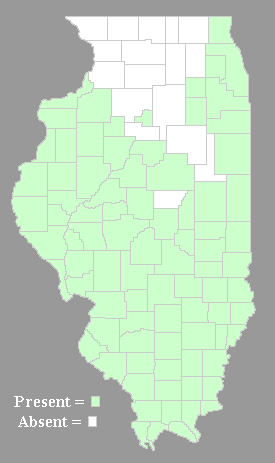Description: This plant is a summer annual that becomes ¾–2' tall, branching occasionally. The stems are covered with fine white hairs. The alternate leaves are up to 2" long and 1" across. They are ovate or ovate-oblong, crenate along the margins, and sparsely covered with fine hairs that are difficult to see. These leaves have long petioles (up to 1" long) and are rounded or slightly cordate at the base. At the base of the petiole, there is a pair of linear stipules; some of the lower leaves also have a blunt green spine below the base of their petioles.

One or a few
flowers develop from the axils of the leaves on short peduncles
(flowering stalks) up to ½" long. These peduncles are shorter than the
petioles, which causes the flowers to appear hidden among the leaves.
Each flower is about 1/3" (8 mm.) across when fully open; it consists
of 5
spreading petals that are light yellow or light orange, 5 sepals that
are green and broadly lanceolate, and a united column of 5 styles and
numerous stamens that becomes spreading at its apex. The petals are
well-rounded and rather floppy; there are pale lines across their upper
surface that function as nectar guides. The blooming period occurs from
mid-summer to early fall and lasts about 1-2 months for a colony of
plants. The flowers usually bloom during bright sunny mornings. Each
flower is replaced by circular seedpod with 5 brown segments that break
apart. Each segment encloses a single seed and has 2 spreading spines
at its apex. The seeds are reddish brown and 3-angled. The root system
consists of a shallow taproot that divides into secondary roots. This
plant spreads by reseeding itself, and it occasionally forms colonies.
Cultivation:
Typical growing conditions are full or partial sun and moist to mesic
soil that is loamy and fertile. Once the seeds germinate, this plant
develops very quickly.

Range & Habitat:
Prickly Sida is fairly common in southern and central Illinois, but
absent from the NW and north central areas of the state. This plant is
probably adventive from tropical America, although some authorities
think it is native to some areas of the United States, including the
lower Midwest. The northern boundary of its range at the time of
European settlement is not entirely clear. Habitats include cropland,
abandoned fields, gardens, grassy areas along railroads and roadsides,
and waste areas where the soil has been recently disturbed. This is
primarily a weed of fields and gardens that is rarely observed in high
quality natural habitats.
Faunal Associations:
The flowers attract various bees, including bumblebees, little
carpenter bees, and Halictid bees, as well as small to medium-sized
butterflies and skippers. Charles Robertson observed the following
Lepidopteran species on the flowers of Prickly Sida: Colias
philodice
(Clouded Sulfur), Eurema lisa (Little Yellow), Pieris
rapae (Cabbage White), Pontia protodice
(Checkered White), and Pyrgus communis (Common
Checkered Skipper). The foliage is not known to be toxic and it may be
eaten occasionally by mammalian herbivores. These animals help to
distribute the seeds as the spines on the segments of the seedpods can
cling to either fur or clothing.
Photographic Location:
An abandoned garden at the webmaster's apartment complex in Urbana,
Illinois.
Comments:
At first glance, this leafy plant does not appear to be a member of the
Mallow family, but a careful examination of the flowers reveals a
united column of styles and anthers that is a typical characteristic of
Mallow flowers. Prickly Sida is a rather unique plant that doesn't
closely resemble other Mallows, which are either small weedy vines,
tall wetland species with huge flowers, or plants with purple or pink
flowers. A distinguishing characteristic of Prickly Sida is the blunt
green spines that occur below the petioles of the lower leaves. The
only other Sida sp. (Sida) in Illinois, Sida
elliottii (Elliott's Sida), is confined to a few southern
counties. It is a more conservative perennial species that occurs in
sand prairies. Elliott's Sida has narrow leaves that are linear-oblong
or oblong, and its yellow flowers are larger in size (½–1" across) than
those of Prickly Sida.